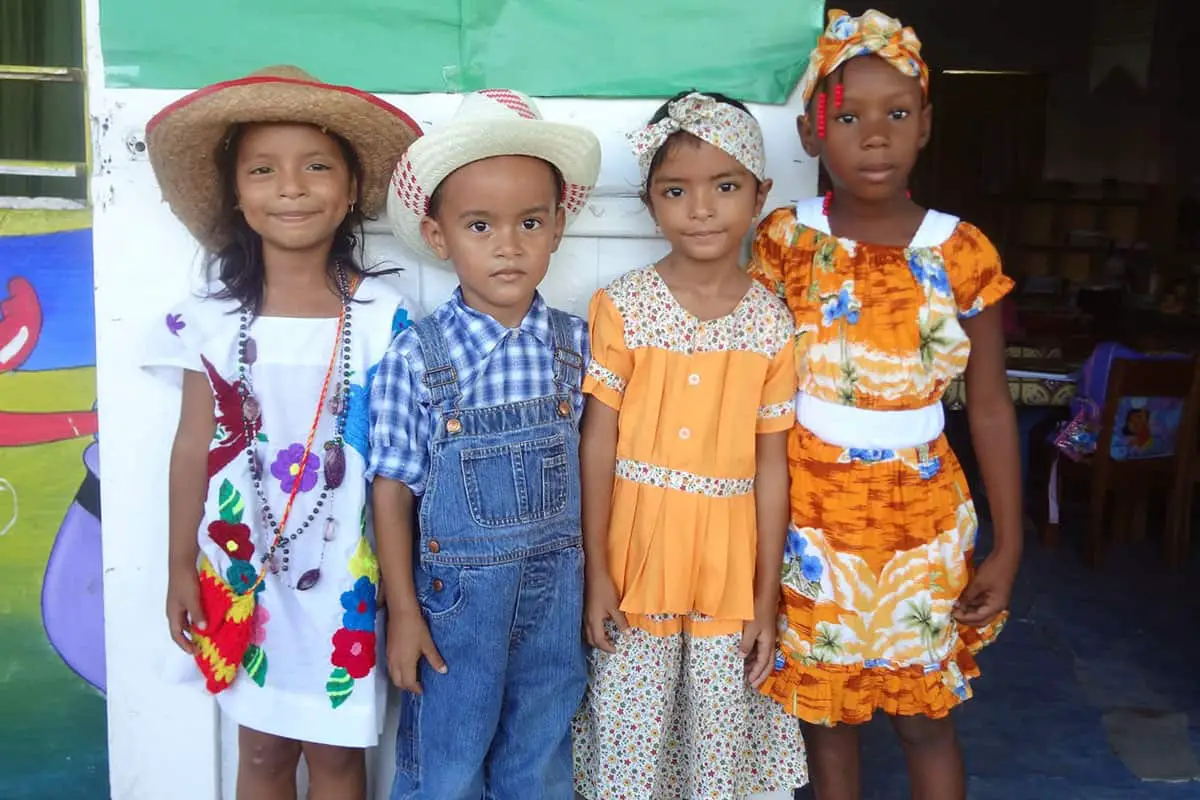Although Belize is the least populated nation in Central America, its population is descended from several ethnicities. One of these ethnic groups is the Garifuna, which may lead to you asking yourself – who are the Garifuna people?
The Garifuna are a group of people who came from the Caribbean island of Saint Vincent and arrived in Belize in 1802 after being deported by the British Army following an unsuccessful uprising. Today, they live in modern-day Central America, including Belize, as well as in the United States.
In this article, we will discuss the origins and history of the Garifuna people. We will also explore their culture, language, food, and music.
Origins of the Garifuna (Garinagu) People
The Garifuna people descended from the Igbo people in modern-day Nigeria who escaped two shipwrecked slave ships near the island of Saint Vincent in 1635 and married the local people of the Arawak and Carib Indians in the Lesser Antilles on the east of the Caribbean Sea.
History of the Garifuna
Following the arrival of the Igbo enslaved people from Nigeria after escaping the shipwrecked ships in 1635, they sought refuge in Saint Vincent, where they settled and married the local indigenous people on the island.
Known as the “Black Caribs,” the Garifuna mounted resistance against the French and the British, which competed for control of Saint Vincent. After France ceded control of the island to Great Britain following their defeat in the Seven Years’ War, the Caribs successfully repelled the British expansion in 1769.
In 1773, the British secured a peace treaty with the local indigenous people, “assuring” the ethnic group of permanent possession of the island. The Garifuna staged a revolt in 1795 against British control of Saint Vincent, but the British Army successfully suppressed them in 1797.
The British Army deported the survivors of the revolt in 1797 to the island of Roatan off the coast of modern-day Honduras. The Garifuna in Roatan later migrated to Central America’s coastal areas with Spain’s help. In 1823, the Garifuna in Honduras migrated to Belize to escape a civil war.
Where Do the Garifuna Live?
Most Garifuna people live in coastal villages in eastern Central America, specifically in Nicaragua, Honduras, Belize, and Guatemala. In Belize, the town of Dangriga (the capital of the Stann Creek District) boasts the country’s largest concentration of Garifuna people.
Because of this concentration of Garifuna people, Dangriga is also considered to be the spiritual capital of the Belizan Garifuna.
In Belize, it is estimated that 15,000 people are descended from the Garifuna or ethnically identify as Garifuna.
Culture of the Garifuna
Like any other ethnic group, the Garifuna have developed their culture over time. Let us discuss the components of their culture.
Language
Also known as the Black Carib language, the Garifuna language belongs to the Arawakan language family.
In 2008, the Garifuna language was inscribed on the United Nations Educational, Scientific, and Cultural Organization (UNESCO) Representative List of the Intangible Cultural Heritage of Humanity.
The Garifuna people also speak Spanish and English.
Garifuna Settlement Day
Celebrated every November 19 each year, Garifuna Settlement Day was created by civil rights activist Thomas Vincent Ramos.
Declared a public holiday in 1977, it marks the arrival of the Garifuna people in Belize in 1802. Major festivities happen, especially in the town of Dangriga.
Flag
Also created by civil rights activist Thomas Vincent Ramos, the Garifuna flag consists of yellow, white, and black horizontal stripes.
While there is a debate concerning the representation of these colors in the flag, the Warasa Garifuna Drum School have described its meaning on their website:
- Yellow: the color of cassava, Carib and Arawak ancestry of the Garifuna, and hope
- White: the skin of the Europeans who were the opponents of the Garifuna people and peace
- Black: the skin and African ancestry of the Garifuna and the adversity they suffered from the Europeans
Food

Garifuna food is based on staples like cassava, coconut, fish, plantains, and bananas. Its taste is usually savory and spicy.
Traditional Dishes
Some traditional Garifuna dishes include:
- Sere: Sere is a creamy fish stew with a coconut base and is often served with white rice. This dish is seasoned with plantains, onion, garlic, cilantro, and other spices.
- Hudut: Similar to sere, this fish stew is made from coconut broth and served with mashed plantains or yams.
- Bundiga: A substitute for hudut, this Garifuna fish soup is made with coconut milk, green bananas, and okra. Cassava bread or coconut white rice can also accompany this dish.
- Ereba: This dish, cooked like a tortilla or crepe, is a staple snack made from cassava root. It was prepared for warriors by the village women. Ereba can last for a long time while maintaining its flavor.
- Darasa: This dish is the Garifuna equivalent of tamales. This traditional snack is made by grating slightly green bananas with coconut milk, lime juice, orange juice, and seasonings.
Music
Garifuna music has been influenced by Afro-Indian, Hispanic, and English Creole cultures. It heavily depends on percussion instruments such as drums and call and response patterns.
There are two main types of drums used in Garifuna music: the Primero and the Segundo. Primero drums have a small diameter that creates a high-pitch sound. On the other hand, the Segundo has a larger diameter that produces a heavier bass sound.
Garifuna drums are made from hardwood like cedar, mahogany, or mayflower. The top of the drum is covered with the dried skin of deer, sheep, goats, or cows.
Here’s a video from Warasa Garifuna Drum School, showcasing a sample of Garifuna music:
Famous Musicians
Famous Garifuna musicians include:
- Andy Palacio: one of Belize’s most admired musicians, Palacio is known for advocating for the Garifuna people and culture.
- Pen Cayetano: the self-taught artist and musician created the musical style known as Punta Rock as a way to preserve the Garifuna culture.
- Paul Nabor: he was associated with popularizing the genre known as paranda.
Clothing
As mentioned above, white, yellow, and black are the colors of the Garifuna flag. They are important colors in Garifuna clothing, and many Garifuna have traditional clothes in these colors.
The traditional clothes of the Garifuna are:
- Women traditionally wear long dresses. They are frequently made with checkered fabrics and are accompanied by a colorful headpiece
- For men, the traditional shirt is the “dashiki.” This long, draped shirt is generally meant to complement a woman’s dress and is therefore made with the same material used in their partner’s dress.
Dance
The Garifuna has also created several dances to accompany their traditional music. Some of them include:
- Hunguhungu: a ritual dance used to communicate between the living and their dead loved ones
- Chumba: a dance performed by women as a protest against the sexual objectification of women suffered during the European colonial era
- Wanaragua: also known as John Canoe, a traditional mask dance during Christmas time performed by males
What Are the Cultural and Historical Similarities and Differences Between the Garifuna and Chinese, Taiwanese, Korean People of Belize?
The Garifuna people of Belize have a rich cultural and historical heritage, with unique traditions and language. Similarly, the Chinese, Taiwanese, and Korean Belizean communities also bring their own cultural heritage and traditions, adding to the diverse tapestry of Belizean history.
Conclusion
Although their history is one of migration and struggle, the Garifuna people flourished over time in Central America, especially in Belize.
Some of them also traveled to the United States and settled there. Their language, music, and dance have been inscribed in UNESCO’s Intangible Cultural Heritage. They have also showcased their culture through their dishes.





